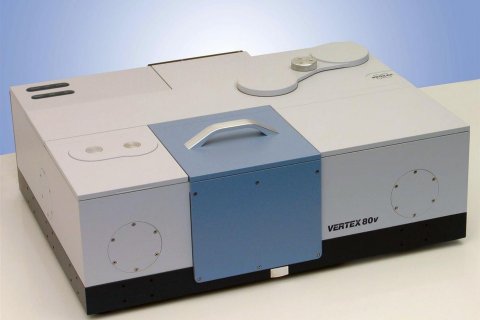The best performing research FTIR spectrometers on the market
The VERTEX 80v provides the top level of the Bruker VERTEX Series high performance FT-IR spectrometers. It offers unmatched performance and versatility for the most demanding research applications.
Common VERTEX features:
VERTEX 80v features:
The actively aligned UltraScanTM interferometer provides PEAK spectral resolution. The infinite life linear air bearing, TrueAlignment of the scanning interferometer arm and PEAK quality optics guarantee the ultimate sensitivity and stability. The innovative TrueAlignment technology does not produce the artifacts, such as ghost peaks and additional noise, that can occur with the dynamic alignment systems used in other spectrometers.
Bruker´s DigiTectTM detector technology ensures lowest electronic noise. It is based on modern dual-channel delta-sigma ADC’s with true 24-bit dynamic range integrated into the detector preamplifier electronics.
Including verTera extension the VERTEX 80v can in its broadest configuration cover an impressive spectral range down to 3 cm-1 without need of cryogenically cooled components. VerTera is applicable with several THz compatible FTIR sample compartment accessories such as transmittance, gas cells, reflectance and THz compatible ATR units, allowing for a unified workflow in a broad spectral range.
With the evacuable optics bench of the VERTEX 80v vacuum FTIR spectrometer, PEAK sensitivity in the mid-, near and far IR/THz regions is obtained without the fear of masking very weak spectral features caused by water vapor or CO2 absorptions. Outstanding results, e.g. in the area of nano-science research down to sub-monolayers, can be obtained.
The step-scan technique allows the monitoring of the temporal progress of very fast reproducible events (transients) down to the very low ns-range. The interferometer mirror consecutively steps to the separate interferogram points one by one where the experiment is restarted again. Temporal resolution up to 2,5 nsec is possible.
For time-resolved spectroscopy of non-reproducible experiments, data can be obtained using the so-called Rapid-Scan technique. In this case the interferometer mirror moves very fast and up to 4 spectra can be extracted from each full forward-backward interferometer scan. Up to 110 spectra acquisition per second possible.
Are you interested in our products, applications and events? Don't miss single thing! You are welcome to subscribe.


